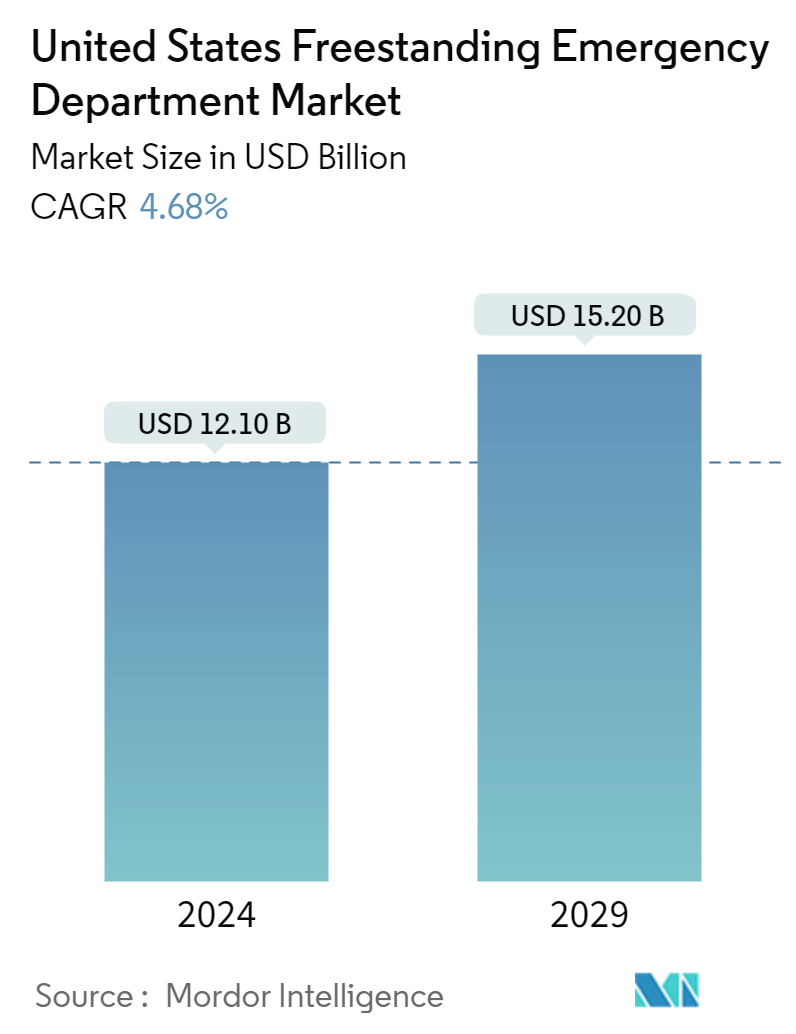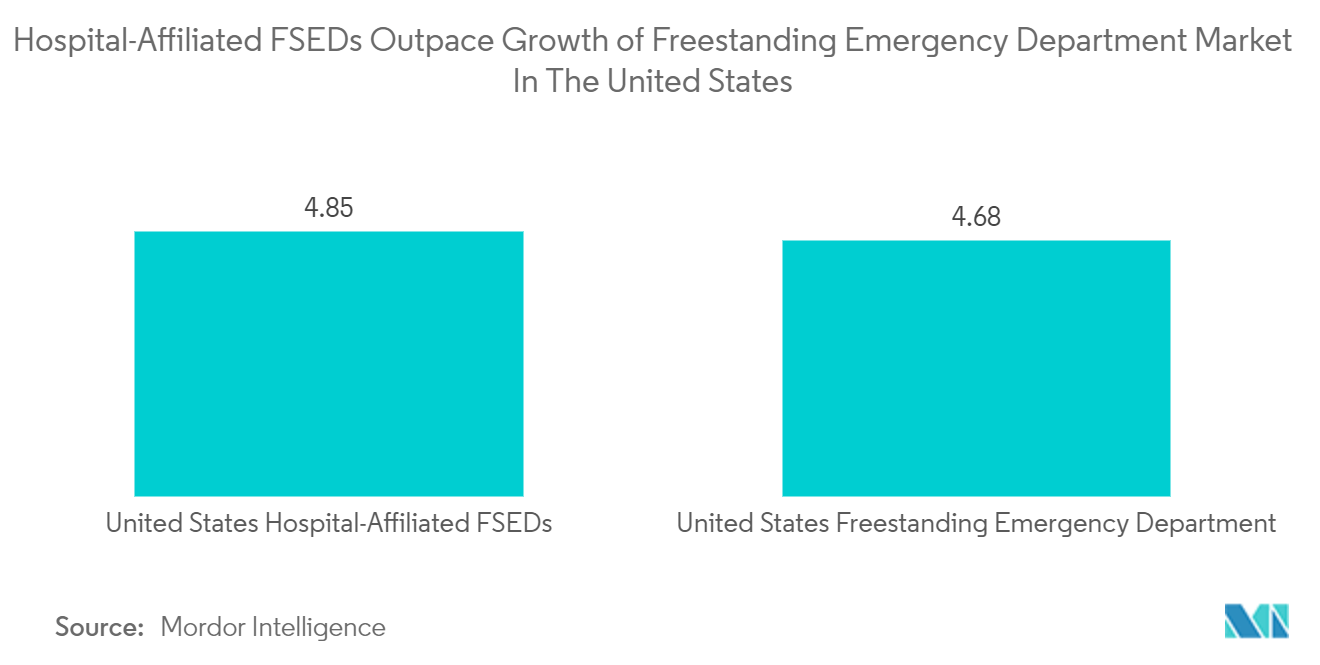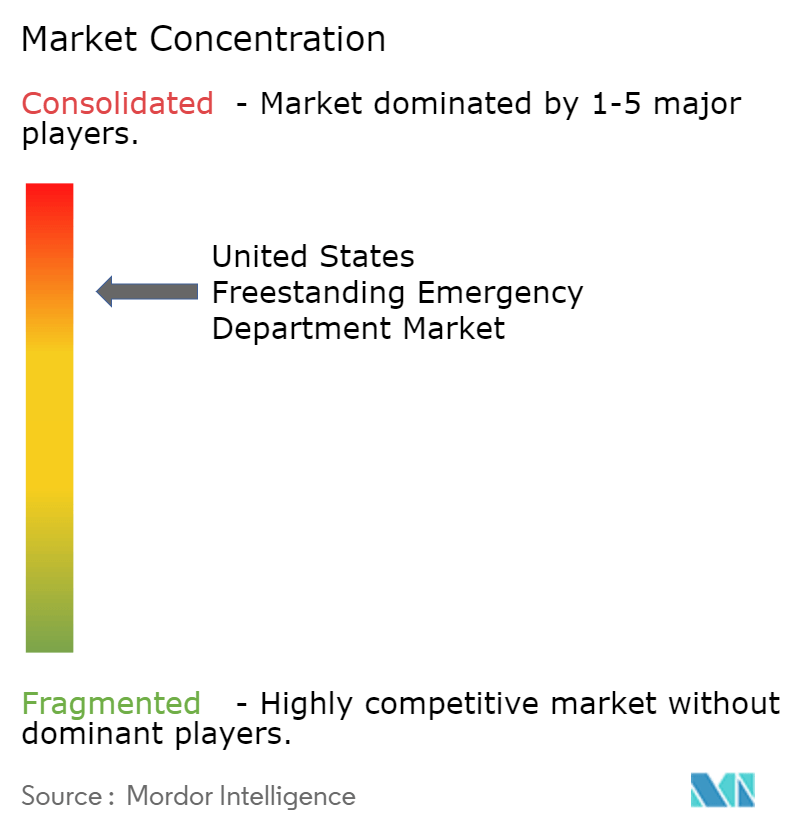United States Freestanding Emergency Department Market Size

| Study Period | 2019 - 2029 |
| Base Year For Estimation | 2023 |
| Market Size (2024) | USD 12.10 Billion |
| Market Size (2029) | USD 15.20 Billion |
| CAGR (2024 - 2029) | 4.68 % |
| Market Concentration | High |
Major Players
*Disclaimer: Major Players sorted in no particular order |
United States Freestanding Emergency Department Market Analysis
The United States Freestanding Emergency Department Market size is estimated at USD 12.10 billion in 2024, and is expected to reach USD 15.20 billion by 2029, growing at a CAGR of 4.68% during the forecast period (2024-2029).
The United States Freestanding Emergency Department (FSED) market is experiencing substantial growth, propelled by evolving healthcare dynamics and shifting consumer expectations. As patient-centric care models gain traction and demand for accessible, high-quality emergency services increases, the FSED landscape is undergoing a significant transformation. Two primary growth drivers—consumer-driven health plans and federal support, along with a growing preference for convenience care—are catalyzing the expansion of FSEDs across the country.
Consumer-Driven Health Plans and Federal Funding: The rapid rise of consumer-driven health plans (CDHPs) is reshaping healthcare access and affordability across the United States. CDHPs encourage patient engagement by promoting cost-conscious decision-making and enabling timely access to healthcare services. In the FSED market, this trend encourages consumers to choose freestanding emergency rooms, which offer cost-effective alternatives for acute care. Federal funding further accelerates the market’s growth, as government-backed initiatives provide financial support for healthcare facilities. For example, the U.S. Department of Health and Human Services’ approval of Colorado's Section 1332 State Innovation Waiver aims to expand coverage, potentially benefiting 10,000 Americans with more affordable health plans. This regulatory support widens the patient base for FSEDs, making emergency care more accessible to a broader demographic.
Rising Preference for Convenience Care: The healthcare consumer's growing demand for convenience is driving a notable shift toward freestanding emergency departments. Patients value quick access, shorter wait times, and 24/7 availability, all of which are core features of FSEDs. These facilities are well-positioned to address these needs, offering high-quality emergency care without the complexity of large hospital environments. Approximately 70% of FSEDs operate round-the-clock, staffed by experienced medical personnel, making them a preferred alternative to traditional emergency rooms. In rural areas, where emergency services have historically been scarce, FSEDs are addressing a critical gap, offering timely care to underserved communities.
The synergy between these key drivers—CDHPs, federal funding, and the rising demand for convenience—is creating a fertile environment for sustained growth in the U.S. FSED market. As healthcare policies continue to evolve, and as consumer expectations shift, FSEDs are poised to become a cornerstone of the modern emergency healthcare system.
United States Freestanding Emergency Department Market Trends
Emergency Care and Other Services: Driving the FSED Market Growth
Segment Dominance: Emergency Care and Other Services represent the largest segment within the U.S. FSED market, covering a broad spectrum of services such as trauma care, acute medical treatment, and specialized services. This segment currently accounts for 49% of the total market size, highlighting its central role in the sector's expansion.
Growth Drivers and Future Outlook: Several factors are fueling the growth of Emergency Care and Other Services. The rising incidence of acute conditions and traumatic injuries requiring immediate intervention is a significant contributor. In addition, FSEDs provide fast and efficient care, with shorter wait times and constant availability, making them increasingly popular. Moving forward, this segment is expected to maintain its dominance as demand for accessible, round-the-clock emergency services rises, particularly in both urban and rural communities.
Competitive Landscape and Disruptions: As competition intensifies, FSED operators are focusing on enhancing their service offerings and integrating advanced technologies. Investments in high-quality diagnostic tools and improving patient flow systems are critical competitive strategies. However, the market is not without its challenges—operators must remain agile in response to potential regulatory shifts or innovations in care delivery models that could disrupt traditional FSED practices.

Hospital-Affiliated FSEDs: Spearheading Market Expansion
Segment Growth Trajectory: Hospital-affiliated FSEDs are the fastest-growing segment within the market, with a projected compound annual growth rate (CAGR) of 4.85% between 2024 and 2029. This segment’s accelerated growth is driven by the integration of FSEDs within larger healthcare networks, allowing hospital systems to extend their emergency care capabilities beyond traditional facilities.
Market Drivers and Future Expectations: The increasing prevalence of chronic diseases, coupled with a growing preference for easily accessible care, is propelling the demand for hospital-affiliated FSEDs. These facilities benefit from strategic locations, leveraging the resources and brand recognition of established hospital systems. Over the next five years, hospital-affiliated FSEDs are expected to play an increasingly vital role in expanding access to emergency care across the United States.
Strategic Considerations and Potential Challenges: To maintain growth, hospital-affiliated FSEDs are focusing on expanding service offerings and integrating advanced diagnostics and telemedicine. Despite the promising outlook, market players must navigate challenges related to changing healthcare reimbursement models and the operational balance between central hospital facilities and their affiliated FSEDs.

United States Freestanding Emergency Department Industry Overview
Market Dominance and Consolidation: Local Powerhouses Lead
The U.S. FSED market is consolidated, with significant participation from regional healthcare providers and large hospital networks. Hospital-affiliated FSEDs make up 59.50% of the market, underscoring their dominance and the preference for facilities backed by established healthcare systems. Major players such as HCA Healthcare and Universal Health Services are leading market development, capitalizing on their regional strength and operational scale.
Key Players: Leveraging Scale and Integration
Leading organizations like CHRISTUS Health, Ascension, and HCA Management Services LP dominate the FSED market through their extensive healthcare networks and established brand presence. HCA Healthcare, for instance, operates 26 FSEDs in the Houston area alone. These top players have invested heavily in strategic expansions, with Universal Health Services managing 27 FSEDs across the country and planning further expansion. Their ability to integrate FSEDs into broader healthcare ecosystems offers them significant advantages in service delivery and operational efficiency.
Strategies for Future Success: Innovation and Accessibility
To sustain market leadership, FSED operators are focusing on innovation and expansion. Advanced diagnostic tools, telemedicine services, and improved patient experiences through reduced wait times and streamlined operations will be essential to maintain competitiveness. Expanding into underserved regions, particularly rural areas with limited access to emergency care, also presents significant growth opportunities. In an increasingly competitive market, forging partnerships with local healthcare providers and community organizations will further strengthen FSEDs' position.
United States Freestanding Emergency Department Market Leaders
-
CHRISTUS Health
-
Ascension
-
Emerus Hospital Partners, LLC.
-
Universal Health Services, Inc.
-
HCA Healthcare
*Disclaimer: Major Players sorted in no particular order

United States Freestanding Emergency Department Market News
- August 2024: Cadence's ER, an extension of Henderson Hospital, commenced operations its operations. This facility is poised to serve patients of all ages, especially as southern Nevada grapples with record-breaking heat and students head back to school. This marks the second freestanding emergency department under Henderson Hospital's umbrella, following the inaugural ER at Green Valley Ranch.
- August 2024: Ascension Sacred Heart unveiled its plans for a new freestanding ER in the Perdido Key area of Escambia County, located off Sorrento Road. The initiative aims to bolster access to emergency services, with construction slated for completion by the summer of 2025.
United States Freestanding Emergency Department Market Report - Table of Contents
1. INTRODUCTION
- 1.1 Study Assumptions and Market Definition
- 1.2 Scope of the Study
2. RESEARCH METHODOLOGY
3. EXECUTIVE SUMMARY
4. MARKET DYNAMICS
- 4.1 Market Overview
-
4.2 Market Drivers
- 4.2.1 Growing Number of Consumer-driven Health Plans and Federal Funding
- 4.2.2 Rising Preference for Convenience Care
-
4.3 Market Restraints
- 4.3.1 High Overall Expenditure
-
4.4 Porter's Five Forces Analysis
- 4.4.1 Threat of New Entrants
- 4.4.2 Bargaining Power of Buyers/Consumers
- 4.4.3 Bargaining Power of Suppliers
- 4.4.4 Threat of Substitute Products
- 4.4.5 Intensity of Competitive Rivalry
5. MARKET SEGMENTATION (Market Size by Value - USD)
-
5.1 By Ownership Type
- 5.1.1 Hospital Affiliated
- 5.1.2 Independent
-
5.2 By Service
- 5.2.1 Laboratory Service
- 5.2.2 Imaging Service
- 5.2.3 Emergency Care and Other Services
6. COMPETITIVE LANDSCAPE
-
6.1 Company Profiles
- 6.1.1 CHRISTUS Health
- 6.1.2 Ascension
- 6.1.3 Emerus Hospital Partners LLC.
- 6.1.4 HCA Healthcare
- 6.1.5 US Acute Care Solutions LLC
- 6.1.6 TH Medical
- 6.1.7 Universal Health Services Inc.
- 6.1.8 Lifepoint Health Inc.
- 6.1.9 Ardent Health Management Services (AHS Management Company Inc.)
- *List Not Exhaustive
7. MARKET OPPORTUNITIES AND FUTURE TRENDS
** Subject To AvailablityUnited States Freestanding Emergency Department Industry Segmentation
Freestanding emergency departments (FSEDs) are healthcare facilities that provide emergency services but are not located on hospital campuses. These FSEDs can be owned by hospitals or act independently. The US Freestanding Emergency Department Market is segmented by ownership type consisting of hospital affiliated and independent subsegments and by service consisting of laboratory service, imaging service, and emergency care and other services. The report offers values (USD) for the above-mentioned segments.
| By Ownership Type | Hospital Affiliated |
| Independent | |
| By Service | Laboratory Service |
| Imaging Service | |
| Emergency Care and Other Services |
United States Freestanding Emergency Department Market Research FAQs
How big is the United States Freestanding Emergency Department Market?
The United States Freestanding Emergency Department Market size is expected to reach USD 12.10 billion in 2024 and grow at a CAGR of 4.68% to reach USD 15.20 billion by 2029.
What is the current United States Freestanding Emergency Department Market size?
In 2024, the United States Freestanding Emergency Department Market size is expected to reach USD 12.10 billion.
Who are the key players in United States Freestanding Emergency Department Market?
CHRISTUS Health, Ascension, Emerus Hospital Partners, LLC., Universal Health Services, Inc. and HCA Healthcare are the major companies operating in the United States Freestanding Emergency Department Market.
What years does this United States Freestanding Emergency Department Market cover, and what was the market size in 2023?
In 2023, the United States Freestanding Emergency Department Market size was estimated at USD 11.53 billion. The report covers the United States Freestanding Emergency Department Market historical market size for years: 2019, 2020, 2021, 2022 and 2023. The report also forecasts the United States Freestanding Emergency Department Market size for years: 2024, 2025, 2026, 2027, 2028 and 2029.
United States Freestanding Emergency Department Industry Report
Statistics for the 2024 United States Freestanding Emergency Department market share, size and revenue growth rate, created by Mordor Intelligence™ Industry Reports. United States Freestanding Emergency Department analysis includes a market forecast outlook to 2029 and historical overview. Get a sample of this industry analysis as a free report PDF download.



